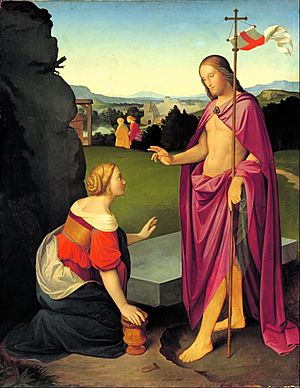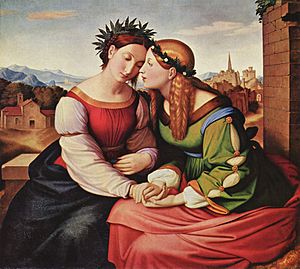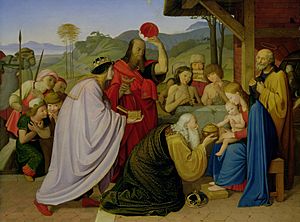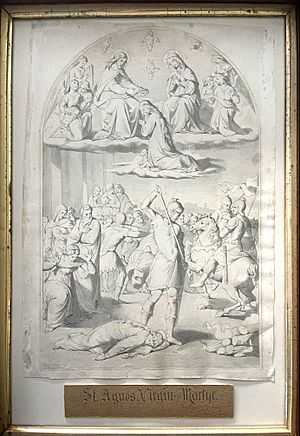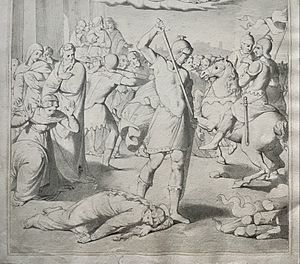Johann Friedrich Overbeck facts for kids
Quick facts for kids
Johann Friedrich Overbeck
|
|
|---|---|
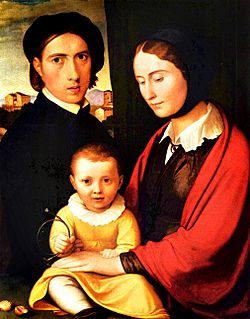
Self-portrait with family, c. 1820, Behnhaus.
|
|
| Born | 3 July 1789 |
| Died | 12 November 1869 (aged 80) |
| Nationality | German and naturalized Italian |
| Education | Heinrich Füger in Vienna |
| Known for | Painting |
| Movement | Neoclassicism |
Johann Friedrich Overbeck (born July 3, 1789 – died November 12, 1869) was an important German painter. He was one of the artists who started the Nazarene art movement. This group of artists wanted to bring back a more spiritual and pure style of art, inspired by earlier Christian art.
Contents
Early Life and Learning About Art
Johann Friedrich Overbeck was born in Lübeck, a city in Germany, in 1789. His family had a strong background in religion. His father was a lawyer, a poet, and even the mayor of Lübeck. Johann grew up learning a lot about classic subjects. He also started to learn about art from a young age.
Becoming an Artist
Art School in Vienna
In March 1806, Overbeck left Lübeck to study art. He went to the art academy in Vienna, Austria. At that time, the academy taught a style called Neoclassicism. This style focused on perfect shapes and classical themes.
However, Overbeck felt that the art taught there lacked deep religious feeling. He believed that art should be more spiritual. He wrote to a friend that the academy didn't encourage noble thoughts. He felt it was missing "heart, soul, sensation!"
Starting the Nazarene Movement
Overbeck believed that art in Europe had lost its Christian focus. He wanted to create art that was pure and spiritual, like the art from the early Renaissance. He looked to artists like Raphael for inspiration.
Because he disagreed with the academy's style, Overbeck and some other young artists formed a group. They called themselves the Guild of St Luke. This name came from a medieval guild for painters. Their goal was to renew art with a focus on faith. After four years, their ideas were so different from the academy's that Overbeck and his friends were asked to leave.
Moving to Rome and New Art
In 1810, Overbeck moved to Rome, Italy. This city became his home for the next 59 years. Other artists who shared his ideas soon joined him. These included Peter von Cornelius and Friedrich Wilhelm Schadow. They lived together in an old monastery. People started calling them the Nazarenes. This name described their simple lifestyle and their focus on religious art.
Their art style was clear and precise. They focused on noble ideas and simple nature. They admired early Italian artists like Perugino and the young Raphael. In 1813, Overbeck became a Roman Catholic. He felt this step helped his art become truly Christian.
Overbeck soon began to receive important art jobs. A Prussian diplomat named Jakob Salomon Bartholdy hired Overbeck and his friends. They painted frescoes (wall paintings) in his house in Rome. Overbeck's paintings showed scenes from the story of Joseph from the Bible. These works were finished in 1818.
Later, Prince Massimo asked Overbeck and other Nazarenes to paint frescoes in his garden pavilion. Overbeck was given the task of illustrating scenes from Tasso's poem, Jerusalem Delivered. One famous painting from this series shows the meeting of Godfrey de Bouillon and Peter the Hermit.
After some time, Overbeck was very busy. He asked his friend Joseph von Führich to help finish some of the frescoes. This gave Overbeck time to work on a painting he truly loved. It was a large wall painting called The Vision of St Francis. He finished this important work in 1830. It was made for a church near Assisi, Italy.
Later Life and Legacy
Overbeck continued to paint many religious works throughout his life. He was honored for his contributions to art. In 1864, he became an honorary member of the American Academy of Arts and Sciences.
His nephew, Johannes Overbeck, also became famous. He was a professor of archaeology and studied art history.
Overbeck passed away in Rome in 1869. He was buried in the church of San Bernardo alle Terme. His art and the Nazarene movement had a lasting impact. They inspired other artists to explore spiritual themes and a simpler, more heartfelt approach to painting.
Works
- Portrait of the Painter Franz Pforra (1810)
- Vittoria Caldoni (1821)
- Christ's Entry into Jerusalem (1824) - This painting was in the Marienkirche but was destroyed during a bombing in 1942.
- Christus am Ölberg (Christ on the Mount of Olives) (1827-1833)
- Italy and Germany (1828)
- Christ's Agony in the Garden (1835)
- Lo Sposalizio (The Marriage of the Virgin) (1836)
- The Triumph of Religion in the Arts (1840)
- Pietà (1846)
- Lamentation of Christ (1846)
- The Incredulity of St. Thomas (1851)
- The Assumption of the Madonna (1855)
- The Ascension of the Virgin Mary (1857)
- Christ Delivered from the Jews (1858) - This painting was commissioned by Pope Pius IX.
- The Seven Sacraments (sketches 1861)
- Baptism (1862-1864)
- Drawings for frescoes in the Cathedral of St. Peter and St. Paul in Đakovo (1867-1869)
See also
 In Spanish: Johann Friedrich Overbeck para niños
In Spanish: Johann Friedrich Overbeck para niños


